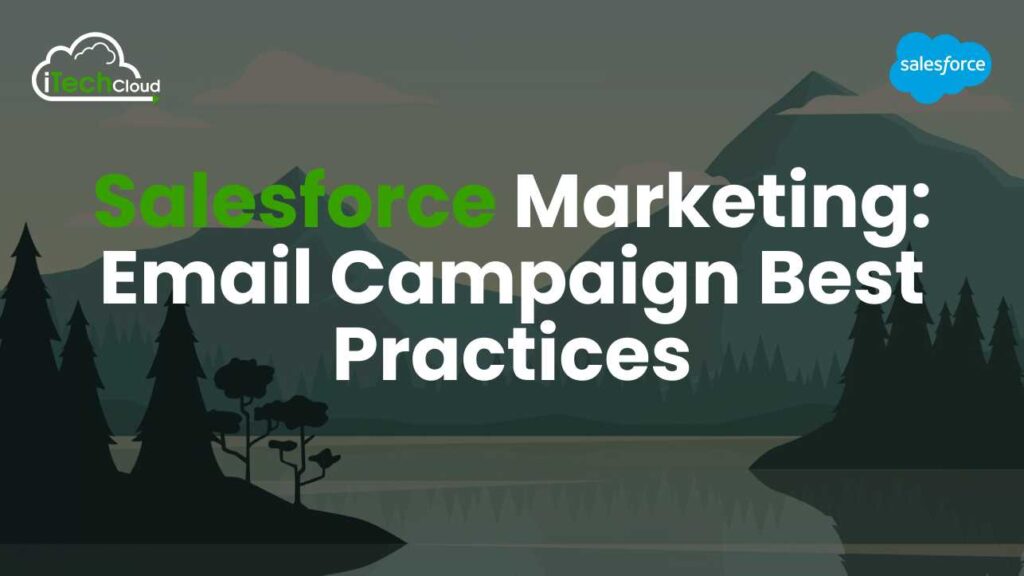Salesforce Marketing: Email Campaign Best Practices

In today’s digital landscape, email marketing remains a cornerstone of any successful marketing strategy. With the right tools and tactics, businesses can leverage email campaigns to engage, nurture, and convert leads into loyal customers. Salesforce Marketing Cloud provides a robust platform for managing and optimizing email campaigns, empowering marketers to deliver personalized and impactful messages at scale. In this comprehensive guide, we’ll explore the best practices for mastering email campaigns with Salesforce Marketing Cloud, covering everything from planning and segmentation to design and analytics.
1. Understanding Salesforce Marketing:
Before launching an email campaign, it’s essential to understand your audience thoroughly. Salesforce Marketing Cloud offers powerful data analytics tools that enable marketers to gather insights into customer behavior, preferences, and demographics. Leveraging this data, marketers can segment their audience into distinct groups based on factors such as purchase history, engagement levels, and interests. By tailoring email content to specific audience segments, marketers can deliver more relevant and personalized messages that resonate with recipients.
2. Setting Clear Objectives:
Every email campaign should have clear and measurable objectives to guide its execution and evaluation. Whether the goal is to drive sales, increase brand awareness, or promote a new product launch, defining key performance indicators (KPIs) ensures that the campaign remains focused and aligned with overarching business objectives. Salesforce Marketing Cloud provides tools for tracking and analyzing campaign performance in real-time, allowing marketers to monitor progress towards their goals and make data-driven optimizations as needed.
3. Crafting Compelling Content:
The success of an email campaign hinges on the quality and relevance of its content. To capture the attention of recipients and drive engagement, marketers should focus on creating compelling and valuable content that resonates with their audience. This includes attention-grabbing subject lines, personalized messaging, and visually appealing design elements. With Salesforce Marketing Cloud’s email builder tools, marketers can easily create and customize email templates that align with their brand identity and messaging.
4. Optimizing for Mobile:
With the majority of email opens now happening on mobile devices, it’s crucial to optimize email campaigns for mobile responsiveness. Salesforce Marketing Cloud offers responsive email templates that automatically adjust to fit the screen size of any device, ensuring a seamless and user-friendly experience for mobile users. Marketers should also pay attention to email design elements such as font size, button placement, and image optimization to maximize readability and engagement on mobile devices.
5. Implementing A/B Testing:
A/B testing is a powerful technique for optimizing email campaigns and maximizing their effectiveness. By testing different elements such as subject lines, CTAs, and content variations, marketers can identify which approaches resonate best with their audience and drive the highest conversion rates. Salesforce Marketing Cloud enables A/B testing at scale, allowing marketers to experiment with different variables and track the performance of each variation in real-time. This iterative approach to campaign optimization can lead to significant improvements in engagement and ROI over time.
6. Personalization at Scale:
Personalization is key to delivering relevant and engaging email experiences that drive action. Salesforce Marketing Cloud’s personalization capabilities enable marketers to dynamically insert personalized content, such as product recommendations, tailored offers, and dynamic content blocks, based on individual customer data and behavior. By leveraging data-driven personalization techniques, marketers can create hyper-targeted email campaigns that resonate with recipients and drive higher conversion rates.
7. Automating Workflows:
Streamlining email campaign workflows through automation can save time and resources while ensuring consistent and timely communication with customers. Salesforce Marketing Cloud offers robust automation capabilities, including triggered emails, drip campaigns, and journey builder tools, that enable marketers to automate various aspects of the email marketing process. By automating tasks such as welcome emails, abandoned cart reminders, and re-engagement campaigns, marketers can deliver relevant messages to customers at key touchpoints in their journey, driving engagement and conversions.
8. Monitoring and Optimization:
Once an email campaign is live, ongoing monitoring and optimization are essential to maximize its impact and ROI. Salesforce Marketing Cloud provides comprehensive analytics dashboards and reporting tools that enable marketers to track key metrics such as open rates, click-through rates, and conversion rates in real-time. By closely monitoring campaign performance and identifying areas for improvement, marketers can make data-driven optimizations to enhance the effectiveness of their email campaigns and drive better results over time.
Conclusion:
Email marketing remains a powerful tool for engaging customers, driving sales, and building brand loyalty. With Salesforce Marketing Cloud, marketers have access to a comprehensive suite of tools and capabilities for planning, executing, and optimizing email campaigns at scale. By following the best practices outlined in this guide, marketers can harness the full potential of email marketing to deliver personalized and impactful messages that resonate with their audience and drive measurable results for their business.

